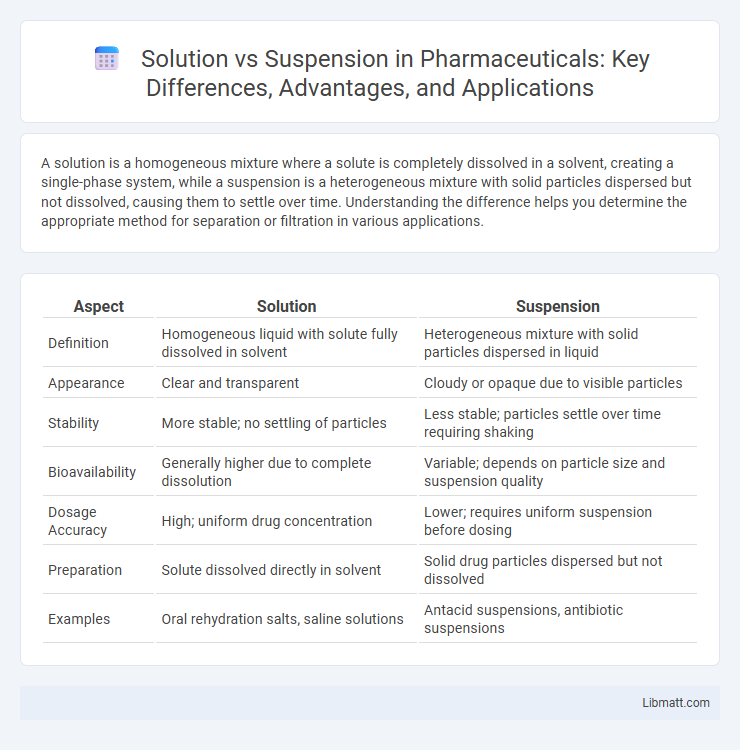A solution is a homogeneous mixture where a solute is completely dissolved in a solvent, creating a single-phase system, while a suspension is a heterogeneous mixture with solid particles dispersed but not dissolved, causing them to settle over time. Understanding the difference helps you determine the appropriate method for separation or filtration in various applications.
Table of Comparison
| Aspect | Solution | Suspension |
|---|---|---|
| Definition | Homogeneous liquid with solute fully dissolved in solvent | Heterogeneous mixture with solid particles dispersed in liquid |
| Appearance | Clear and transparent | Cloudy or opaque due to visible particles |
| Stability | More stable; no settling of particles | Less stable; particles settle over time requiring shaking |
| Bioavailability | Generally higher due to complete dissolution | Variable; depends on particle size and suspension quality |
| Dosage Accuracy | High; uniform drug concentration | Lower; requires uniform suspension before dosing |
| Preparation | Solute dissolved directly in solvent | Solid drug particles dispersed but not dissolved |
| Examples | Oral rehydration salts, saline solutions | Antacid suspensions, antibiotic suspensions |
Defining Solutions and Suspensions
Solutions are homogeneous mixtures where solutes dissolve completely in solvents, resulting in a single-phase system with uniform composition at the molecular level. Suspensions are heterogeneous mixtures containing solid particles dispersed in a liquid, where particles remain undissolved and can settle over time, requiring agitation to maintain uniformity. The key distinction lies in particle size and solubility; solutions have solute particles smaller than one nanometer, while suspensions have larger, visible particles.
Key Characteristics of Solutions
Solutions are homogeneous mixtures where solutes completely dissolve in solvents, creating a single-phase system with uniform composition throughout. Key characteristics of solutions include particle sizes typically less than 1 nanometer, the inability of solute particles to be separated by filtration, and transparency that allows light to pass without scattering. Your understanding of these properties helps distinguish solutions from suspensions, which contain larger particles that settle over time and can be filtered out.
Key Characteristics of Suspensions
Suspensions consist of solid particles dispersed throughout a liquid or gas medium, where the particles are larger than those in solutions and are not fully dissolved. These particles tend to settle out over time due to gravity, requiring agitation or shaking to redistribute them evenly. Suspensions exhibit distinct properties such as turbidity, and their components can be separated by filtration, contrasting with the homogeneous nature of solutions.
Differences in Particle Size
Solutions contain particles at the molecular or ionic level, typically less than 1 nanometer, making them completely homogeneous and transparent with no visible particles. Suspensions have much larger particles, usually greater than 1000 nanometers, that are dispersed but not dissolved, causing the mixture to appear cloudy or opaque and often causing particles to settle over time. Understanding these differences in particle size can help you determine the appropriate method for mixing and separating substances in various applications.
Homogeneity vs Heterogeneity
A solution is a homogeneous mixture where the solute is uniformly dispersed at the molecular level, resulting in a single-phase system. In contrast, a suspension is a heterogeneous mixture containing larger particles that are not dissolved and can settle over time. Understanding the distinction between these two helps you effectively predict mixture behavior in various chemical and practical applications.
Methods of Preparation
Solutions are prepared by dissolving solutes completely in solvents, often using techniques like stirring, heating, or ultrasonication to enhance solubility and achieve molecular-level dispersion. Suspensions require mechanical agitation to uniformly disperse insoluble solid particles within a liquid medium without dissolving, commonly achieved through vigorous shaking, homogenization, or use of stabilizing agents to prevent sedimentation. Precise control of particle size and stabilization methods ensures suspension stability, whereas solutions rely on the complete dissolution process for homogeneity.
Stability and Separation
Solutions exhibit high stability with solutes completely dissolved at the molecular level, preventing separation over time. In suspensions, particles are larger and dispersed, resulting in less stability and visible separation without constant agitation or settling over time. Your choice depends on whether you require a uniform mixture or a system prone to phase separation.
Examples of Solutions and Suspensions
Solutions include seawater, sugar dissolved in water, and rubbing alcohol, where the solute is completely dissolved into the solvent, creating a uniform mixture. Suspensions consist of mixtures like muddy water, flour in water, and sand in water, where solid particles are dispersed but not dissolved, causing the mixture to be heterogeneous. Understanding these examples helps you distinguish how solutions are homogeneous while suspensions contain visible particles that eventually settle.
Applications in Daily Life
Solutions, where substances are completely dissolved, are commonly found in daily life such as in saltwater or sugar dissolved in tea, making them essential for cooking and beverages. Suspensions contain larger particles that remain dispersed but separate upon standing, as seen in salad dressings or muddy water, which require shaking before use to redistribute particles. Your understanding of these differences helps in selecting proper methods for storage or preparation in routine activities.
Summary Table: Solution vs Suspension
A solution is a homogeneous mixture where the solute is completely dissolved in the solvent, resulting in a clear and stable liquid, whereas a suspension is a heterogeneous mixture containing solid particles dispersed throughout a liquid that settle over time. In a solution, particle size is at the molecular or ionic level (less than 1 nanometer), preventing light scattering and sedimentation, while suspensions have larger particles (greater than 1000 nanometers) that cause turbidity and require agitation to remain evenly distributed. Solutions cannot be separated by filtration, unlike suspensions, where particles can be separated using methods such as filtration or centrifugation, highlighting differences in physical properties and applications.
Solution vs suspension Infographic

 libmatt.com
libmatt.com